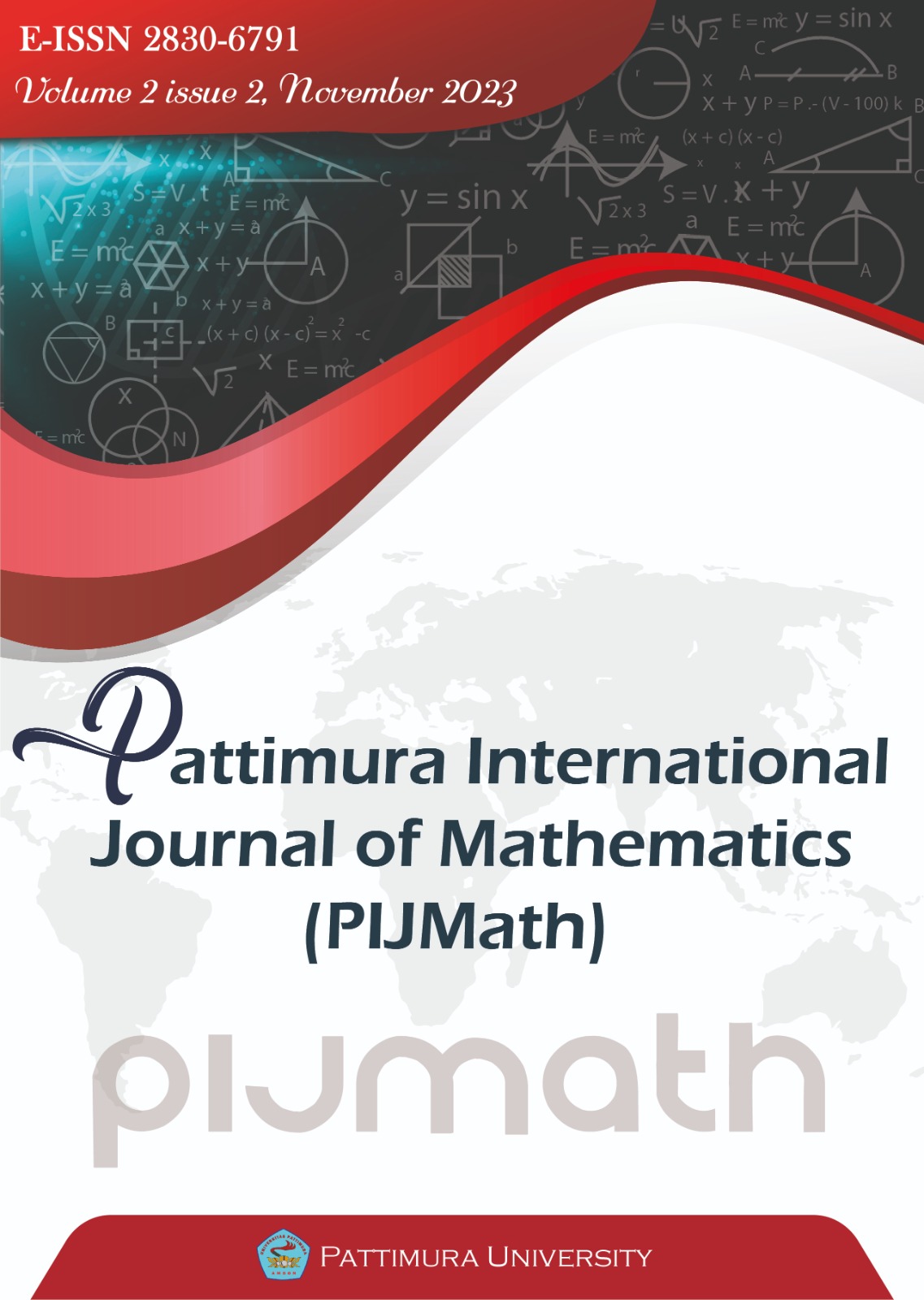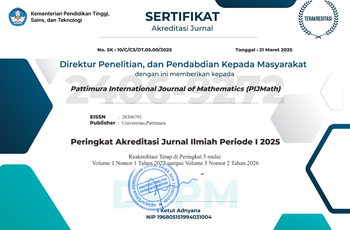The Influence of Macroeconomic Factors on Credit Risk of Banks in Indonesia using ARDL Model
Abstract
One of the efforts to maintain economic stability during the Covid-19 pandemic is to reduce the risk of in the banking sector. One of the risks in the banking sector that must be anticipated is credit risk. Non-Performing Loan (NPL) is one of the indicators used to detect credit risk. There are various factors that can affect credit risk, both from internal and external banking. One of the external factors that can affect NPL is macroeconomic conditions. This study aims to identify macroeconomic factors that affect banking NPLs in Indonesia using the autoregressive distributed lag (ARDL) model. The data used is time series data from January 2015 – August 2020, which period describes the condition of the Indonesian economy before and during the Covid-19 pandemic. The data consists of six variables, namely the NPL ratio of commercial banks and macroeconomic factors in Indonesia such as gross domestic product (GDP), inflation rate, USD-IDR exchange rate, benchmark interest rates [BI 7-Day (Reverse) Repo Rate], and credit growth. The results of the data analysis show that the NPL ratio and macroeconomic variables are experiencing shocks due to the COVID-19 pandemic. The results of the ARDL model analysis show that these macroeconomic variables are able to explain the NPL of 66.61%
Downloads
References
[2] B. Scholtens and D. van Wensveen, "The Theory of Financial Intermediation: An Essay On What It Does (Not) Explain," SUERF – The European Money and Finance Forum, Vienna, 2003.
[3] R. Levine, "Finance and Growth: Theory And Evidence," NATIONAL BUREAU OF ECONOMIC RESEARCH, Massachusetts, 2004.
[4] S. H. Boahene, J. Dasa and S. K. Agyei, "Credit risk and profitability of selected banks in Ghana," Research Journal of Finance and Accounting, vol. 3, no. 7, pp. 6-14, 2012.
[5] A. Ali and K. J. Daly, "Modelling Credit Risk: A comparison of Australia and the USA," Journal of International Finance and Economics, vol. 10, no. 1, pp. 123-131, 2010.
[6] G. Fainstein and I. Novikov, "The Comparative Analysis of Credit Risk Determinants in the Banking Sector of the Baltic States," Review of Economics & Finance, vol. 1, no. June, pp. 20-45, 2011.
[7] R. Mileris, "Macroeconomic Determinants of Loan Portfolio Credit Risk in Banks," Engineering Economics, vol. 23, no. 5, pp. 496-504, 2012.
[8] K. I. Nikolopoulos and A. I. Tsalas, "Non-performing Loans: A Review of the Literature and the International Experience," in Non-Performing Loans and Resolving Private Sector Insolvency: Experiences from the EU Periphery and the Case of Greece, Palgrave Macmillan Cham, 2017, pp. 47-68.
[9] C. M. Reinhart and K. S. Rogoff, "Growth in a Time of Debt.," American Economic Review, vol. 100, no. 2, pp. 573-578, 2010.
[10] R. Olivares-Caminal and A. Miglionico, "Non-performing Loans: Challenges and Options for Banks and Corporations," in Non-Performing Loans and Resolving Private Sector Insolvency: Experiences from the EU Periphery and the Case of Greece, Palgrave Macmillan , 2017, pp. 17-45.
[11] A. Glogowski, "Macroeconomic Determinants of Polish Banks’ Loan Losses – Results of a Panel Data Study," Department of Information and Public Relations - National Bank of Poland, Warsaw, 2008.
[12] M. Nkusu, "Nonperforming loans and macro financial vulnerabilities in advanced economies," International Monetary Fund, 2011.
[13] D. P. Louzis, A. T. Vouldis and V. L. Metaxas, "Macroeconomic and bank-specific determinants of non-performing loans in Greece: A comparative study of mortgage, business and consumer loan portfolios," Journal of Banking & Finance, vol. 36, no. 4, pp. 1012-1027, 2012.
[14] P. Jakubík and T. Reininger, "Determinants of Nonperforming Loans in Central, Eastern and Southeastern Europe," Focus on European Economic Integration, vol. 2013, no. 3, pp. 48-66, 2013.
[15] N. Klein, "Non-Performing Loans in CESEE: Determinants and Impact on Macroeconomic Performance," International Monetary Fund, 2013.
[16] A. Ghosh, "Banking-industry specific and regional economic determinants of non-performing loans: Evidence from US states," Journal of Financial Stability, vol. 20, no. C, p. 93–104, 2015.
[17] B. Skarica, "Determinants of non-performing loans in Central and Eastern European countries," Financial Theory and Practice, vol. 38, no. 1, pp. 37-59, 2014.
[18] V. Makri, A. Tsagkanos and A. Bellas, "Determinants of Non-Performing Loans: The Case of Eurozone," Panoeconomicus, vol. 61, no. 2, pp. 193-206, 2014.
[19] I. Bucur and S. E. Dragomirescu, "The Influence of Macroeconomic Conditions on Credit Risk: Case of Romanian Banking System," Studies and Scientific Researches, vol. Economics Edition, no. 19, pp. 84-95, 2014.
[20] T. Mondal, "Sensitivity of Non-Performing Loan to Macroeconomic Variables: Empirical Evidence from Banking Industry of Bangladesh," Global Journal of Management and Business Research: C Finance, vol. 16, no. 4, pp. 21-28, 2016.
[21] E. Nikolaidou and S. Vogiazas, "Credit Risk Determinants for the Bulgarian Banking System," International Advances in Economic Research, vol. 20, no. 1, pp. 87-102, 2014.
[22] E. Nikolaidou and S. Vogiazas, "Credit risk determinants in Sub-Saharan banking systems: Evidence from five countries and lessons learnt from Central East and South East European countries," Review of Development Finance, vol. 7, no. 1, pp. 52-63, 2017.
[23] M. R. Yusuf and Fakhruddin, "Analisis Variabel Makro dan Rasio Keuangan terhadap Kredit Bermasalah," Jurnal Ilmiah Mahasiswa Ekonomi Pembangunan, vol. 1, no. 2, pp. 555-562, 2016.
[24] Ekananda and Mahjus, "Analysis of the Macroeconomic Impact towards the NPL National Banking in Indonesia: The Study of Macro-Economic Shock Using Vector Autoregression Models," European Research Studies Journal, vol. XX, no. 3A, pp. 396-416, 2017.
[25] R. F. Engle and C. W. J. Granger, "Co-Integration and Error Correction: Representation, Estimation, and Testing," Econometrica, vol. 55, no. 2, pp. 251-276, 1987.
[26] L. J. Sinay, S. J. Latupeirissa, S. M. Pelu and M. I. Tilukay, "The Impact of Bank-Specific Factors on Non-Performing Loan in Indonesia: Evidence From ARDL Model Approach," BAREKENG: Jurnal Ilmu Matematika dan Terapan, vol. 16, no. 2, pp. 675-686, 2022.
[27] S. D. Vogiazas, "Determinants Of Credit Risk In The Bulgarian And The Romanian Banking Systems And The Role Of The Greek Crisis," Thesis submitted to the Department of Economics of Sheffield University in fulfillment of the requirements for the degree of Doctor of Philosophy, South East European Research Centre at Thessaloniki, 2015.
[28] E. Nkoro and A. K. Uko, "Autoregressive Distributed Lag (ARDL) Cointegration Technique: Application and Interpretation," Journal of Statistical and Econometric Methods, vol. 5, no. 4, pp. 63-91, 2016.
[29] N. Adeleye, E. Osabuohien, E. Bowale, O. Matthew and E. Oduntan, "Financial reforms and credit growth in Nigeria: Empirical insights from ARDL and ECM techniques.," International Review of Applied Economics, vol. 32, no. 6, pp. 807-820, 2018.
[30] G. Baoko, I. A. Acheampong and M. Ibrahim, "Determinants of bank credit in Ghana: a bounds-testing cointegration approach," African Review of Economics and Finance, vol. 9, no. 1, pp. 33-61, 2017.
[31] M. H. Pesaran and Y. Shin, "An Autoregressive Distributed-Lag Modelling Approach to Cointegration Analysis," in Econometrics and Economic Theory in the 20th Century: The Ragnar Frisch Centennial Symposium, Cambridge University Press, 1999, pp. 371 - 413.
[32] M. H. Pesaran, Y. Shin and R. Smith, "Bounds Testing Approaches to the Analysis of Level Relationships," Journal of Applied Econometrics, vol. 16, no. 3, p. 289–326, 2001.
[33] Financial Services Authority (OJK), Indonesia Banking Statistics, Jakarta: Banking Licensing and Information Department, Financial Services Authority, Republic of Indonesia, 2021.
Copyright (c) 2023 Lexy Janzen Sinay, Esther Kembauw

This work is licensed under a Creative Commons Attribution-NonCommercial 4.0 International License.
The author(s) hold the copyright of the published article without restriction. This policy means that the journal allows the author(s) to hold and retain publishing rights without restrictions.
The author(s) holds the copyright of published articles without limitation. This policy means that the journal allows the author to hold and retain publishing rights without restrictions. Journal editors are given the copyright to publish articles in according to agreement signed by the author and also include statement of originality of the article


.jpg)












 This work is licensed under a
This work is licensed under a 